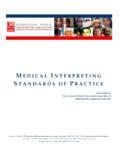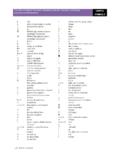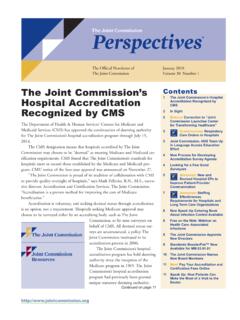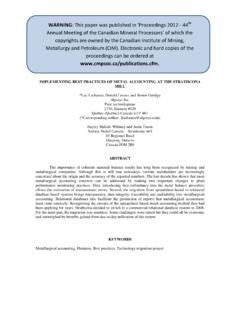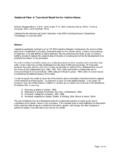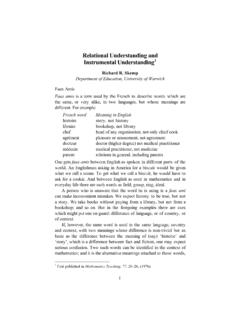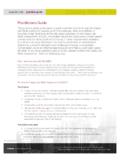Transcription of Medical Interpreting Standards of Practice 042810
1 ME D I C A L IN T E R P R E T I N G ST A N D A R D S O F PR A C T I C E Developed by: International Medical Interpreters Association & Education Development Center, Inc. Adopted October, 1995. International Medical Interpreters Association. Copyright 2007, 1998, 1997, 1996 by International Medical Interpreters Association, now International Medical Interpreters Association and Education Development Center, Inc. All rights reserved. Printed in the United States of America. Medical Interpreting Standards OF Practice 2 Terms of Use No part of this publication may be reproduced, stored in a retrieval system, or transmitted, in any form or by any means, electronic, mechanical, photocopying, recording, or otherwise (unless used for communication with the authors) without permission of the authors.
2 Discrimination Prohibited: No person in the United States shall, on the grounds of race, color, or national origin, be excluded from participation in, be denied the benefits of, or be subjected to discrimination under any program or activity receiving Federal financial assistance, or be so treated on the basis of sex under most education programs or activities receiving Federal assistance. The activity that is the subject of this report was developed with support from the International Medical Interpreters Association and the Department of Education, Fund for the Improvement of Postsecondary Education. The opinions expressed herein do not necessarily reflect the position or policy of the Department of Education, and no official endorsement by the Department should be inferred.
3 For more information on the development of the Standards , contact: Mar a-Paz Beltr n Avery Education Development Center, Inc. 55 Chapel Street Newton, MA 02458-1060 The Standards of Practice are available online at no cost at: For ordering print copies please go to: For information on the International Medical Interpreters Association go to: International Medical Interpreters Association 750 Washington Street, NEMC Box 271 Boston, MA 02111-1845 E-mail: Medical Interpreting Standards OF Practice 3 To Raquel Cashman, friend and colleague, whose concern for excellence, justice, and harmony guides this work. Medical Interpreting Standards OF Practice 4 Table of Contents Preface from October 1998 The Development The Standards of A. B. Cultural C. Ethical Potential Looking to the Medical Interpreting Standards of Evaluation Duty A: A-1 Introduce self and explain A-2 Manage the spatial configuration of patient-provider-interpreter to maximize ease and directness of A-3 Maintain the linguistic register and style of the A-4 Address the comfort needs of the patient in relation to the interpreter with regard to factors such as age, gender, and other potential areas of A-5 Select appropriate mode of interpretation (consecutive, simultaneous, sight translation; first or third person).
4 26 A-6 Accurately transmits information between patient and A-7 Encourage direct communication between patient and A-8 Ensure that the listener understands the A-9 Ensure that the interpreter understands the message to be Medical Interpreting Standards OF Practice 5 A-10 Manage the flow of communication in order to preserve accuracy and completeness, and to build rapport between provider and A-11 Manage the dynamics of the A-12 Manage personal internal A-13 Manage conflict between provider and A-14 Do a self-check on accuracy of interpretation and correct own A-15 Assist the provider with interview closure A-16 Ensure that concerns raised during or after an interview are addressed and referred to the appropriate A-17 Complete appropriate documentation of the interpreter s A-18 Follow up (outside the triadic encounter) as Duty B: Cultural B-1 Use culturally appropriate B-2 Recognize and address instances that require intercultural inquiry to ensure accurate and complete Duty C.
5 Ethical C-1 Maintain C-2 Interpret accurately and C-3 Maintain C-4 Respect patient s C-5 Maintain professional C-6 Maintain professional C-7 Deal with Medical Interpreting Standards OF Practice 6 Acknowledgements Subcommittee on Standards of Practice Margarita Battle - Coordinator of Interpreter Services, Massachusetts General Hospital Eduardo Berinstein - Director of Interpreter Services, Children s Hospital Raquel Cashman - Former Director of Interpreter Services, Boston City Hospital Jane Crandall - Coordinator of Interpreter Services, Beth Israel Hospital Maria Durham - Director of Interpreter Services, University of Massachusetts Medical Center Mar a-Paz Beltr n Avery - Director, Medical Interpreter Training Project, EDC Acknowledgement to the participants of the DACUM Process Margarita Battle - Massachusetts General Hospital Eduardo Berinstein - Children s Hospital Alm Raa Chhan Freelance Medical interpreter Jane Crandall - Beth Israel Hospital Maria Durham - University of Massachusetts Medical Center Gregory Figaro Freelance Medical interpreter Carla Fogaren - Good Samaritan Medical Center Alicia D.
6 Hart - Brigham and Women s Hospital Tot Nguyen Freelance Medical interpreter Saly Pin-Riebe - Department of Mental Health, Refugee Assistance Program Margarita Restrepo - Beth Israel Hospital Raquel Santander-Nelson Freelance Medical interpreter Joyce Malyn-Smith - Education Development Center, Inc., DACUM Facilitator Medical Interpreting Standards OF Practice 7 Preface The International Medical Interpreters Association is very proud of its legacy as a pioneer in the Medical Interpreting field. The Medical Interpreting Standards of Practice document was the first set of Standards to be developed in the field of spoken language Interpreting in Medical settings, and remains a vital evaluation and competency tool for professional interpreters all over the country, delineating core performance Standards and competencies required of a competent interpreter.
7 These Standards were developed using the DACUM process that was done by Education Development Center, which is a well known and validated method of occupational analysis for professional and technical jobs. It was developed with the intention of being the grounding work needed for Medical interpreter certification. Adopted on a national level at the 4th National Working Group conference in Seattle, WA, May 17th -- 19th, 1998; see , it became widely used across the country and even abroad. Since the development of the Medical Interpreting Standards of Practice , other Standards have been developed: notably the American Society for Testing and Materials (ASTM) Standards in 2001, the California Healthcare Interpreters Association (CHIA) Standards in 2002, and the National Council for Interpreting in Health Care (NCIHC) Standards in 2005, each with a different perspective and approach that has enriched the understanding of the Practice of this profession.
8 While these organizations worked hard to develop their Standards , we take this opportunity to focus on the continuous dissemination, implementation and enforcement of our Standards for the profession. The IMIA noted recently that although our Standards are most appropriate as an evaluation tool, many who have entered the field are not familiar with these Standards of Practice or have not been tested or evaluated by this tool. Several training organizations already utilize these Standards as a teaching tool, and we encourage and promote its use as a final evaluation tool as well. Each IMIA member receives a copy when he/she joins the organization. In the absence of, and as interpreters wait for national Medical interpreter certification, the profession will benefit from IMIA workshops to teach interpreters about this tool, and also to teach interpreter trainers on how to utilize this tool for performance evaluation.
9 The IMIA wishes to collaborate with other organizations that work with, train, and hire Medical interpreters who are ready to uphold the performance Standards delineated in this document. We also welcome the feedback of those that use this tool on a regular basis and letters of endorsement to these Standards . The main obstacles to dissemination were the cost and availability of the Standards . Therefore, the IMIA Board of Directors voted in 2006 to make this document available in pdf format and free of charge. Further dissemination will also promote adherence to the Medical Interpreting Standards required to ensure patient safety. It is with this vision that the IMIA presents this document to all professional Medical interpreters and other stakeholders in the field. I also take this opportunity to state that each of the four Standards presented above are equally important to interpreters, who will benefit from becoming familiar with each one of them.
10 These Standards are now being translated into several languages to facilitate international dissemination. Sincerely, Izabel S. Arocha, IMIA President August 2007 Medical Interpreting Standards OF Practice 8 Preface from October 1998 printing The document, Medical Interpreting Standards of Practice , has received national and international recognition since it was first adopted in 1995. In May of 1998, the National Council on Interpretation in Health Care (NCIHC), a group of interpreters, managers of interpreter services, providers, educators, trainers, and other concerned entities committed to promote and support culturally competent Medical interpretation to ensure equitable access to quality health care, made the following statement: The National Council on Interpretation in Health Care has reviewed the Medical Interpreting Standards of Practice and has voted to advocate use of this document as the best statement of Standards for Medical interpreters presently available.
